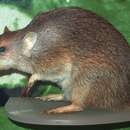Biology
(
İngilizce
)
Arkive tarafından sağlandı
The golden bandicoot is a nocturnal marsupial. It constructs a nest in dense vegetation or in logs, using sticks, leaves and grass, in which it rests during the day (2). This marsupial's night vision and sense of smell are well-developed. It forages for insects, small reptiles and roots at night (3).
Bandicoots are notable for having one of the highest reproductive rates of all marsupials (3). The gestation period lasts only 12.5 days and is one of the shortest gestation periods of all mammals (4). Females give birth to two to three young. The offspring crawl into the mother's pouch and are carried there for seven weeks. After this there is little parental care, a trait that enables adult bandicoots to mate and reproduce several times a year (3).
Conservation
(
İngilizce
)
Arkive tarafından sağlandı
This species occurs and is protected in the Prince Regent Nature Reserve, Kimberley, and in Barrow Island and Middle Island Nature Reserves (5). Islands are recognised as extremely important areas for vulnerable species, especially those species which are threatened on the mainland, such as the golden bandicoot. Recovery Plans have been established to define the causes of this species' decline and to address these in the species' present range. The eradication of rats (Rattus rattus) from Middle Island is now underway. There are also plans to set up captive breeding colonies, and reintroduce individuals to areas where they were once found (5).
Description
(
İngilizce
)
Arkive tarafından sağlandı
The golden bandicoot is a small omnivorous marsupial found in Australia (4). This mammal is ratlike in appearance, with a small hunched body posture and a long tail. It has large muscular hind limbs, short forelimbs and forefeet with three toes bearing flat claws. Unlike other marsupials, bandicoots have fused toes on their hind feet, which form a comb for grooming (3). Most bandicoots have noticeably long snouts and large ears. However, this species belongs to the genus Isoodon, the short-nosed bandicoots, which have shorter muzzles (3). The ears are small and rounded, and females have a rear-opening pouch containing eight teats (3). As its name suggests, this small marsupial's fur is a golden-brown colour (3).
Habitat
(
İngilizce
)
Arkive tarafından sağlandı
Inhabits spinifex grasslands (of the genus Trodia) and tussock grasslands (5).
Range
(
İngilizce
)
Arkive tarafından sağlandı
This species was once widespread in central Australia. By 1992 it had been lost from most of its mainland range, except for a small area in northwest Kimberly (5). In 2000 a report was published by the National Wildlife and Parks Service revealing that this species was presumed to be extinct on the mainland (6). It remains on Barrow, Middle, and Augustus Islands (5).
Status
(
İngilizce
)
Arkive tarafından sağlandı
This species is classified as Vulnerable (VU B1+2e) on the IUCN Red List 2003 (1).
Threats
(
İngilizce
)
Arkive tarafından sağlandı
This species has been lost from most of its former range (5). It is thought that reasons for this include changes to fire regimes, competition with rabbits and predation from introduced mammals such as the European red fox (Vulpes vulpes) (5).

